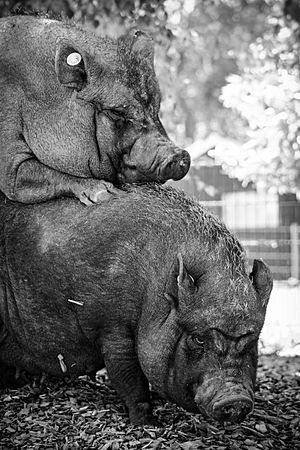Miniature pig facts for kids

Two female miniature pigs, one of which is attempting to mount the other
|
|
| Traits | |
|---|---|
|
Miniature pigs, also known as Mini Pigs, Micro Pigs, Teacup Pigs, or Pygmy Pigs, are small types of domestic pigs. They are often bred from specific pig breeds. Some examples include the Vietnamese Pot-Bellied pig, Göttingen minipig, Juliana pig, Choctaw hog, or Kunekune. Sometimes, they are also a mix of these breeds.
Miniature pigs usually have certain features. They have small ears that perk back. They also have a pot belly and a swayed back. Their bodies are chubby, with a rounded head and a short snout. They have short legs and a short neck. Their tail has thick hair at the end. Typically, these pigs weigh between about 32 kg (70 lb) and 68 kg (150 lb).
Contents
The Story of Mini Pigs: How They Became Popular
Early Uses of Smaller Pigs
In the 1960s, smaller Chinese pigs were sent to zoos in Western cities. These pigs weighed about 68 to 90 kg (150 to 200 lb). They were also used for important medical research. Scientists found these smaller pigs easier to work with. Larger pig breeds can weigh much more, often 136 to 227 kg (300 to 500 lb).
Pot-Bellied Pigs Arrive in North America
In the mid-1980s, a man named Keith Connell brought breeding Vietnamese Pot-Bellied pigs to Canada. These pigs became the first pot-bellied pigs in North America. This breed is known for being small. They also have a swayed back and a noticeable pot belly.
Because of special customs rules, only the babies of these pigs could be sold in the United States. At first, zoos in the U.S. wanted the piglets. But soon, people started buying them as pets. Pet pot-bellied pigs became very popular. They lived in many places, from city apartments to suburban homes.
Over the next 10 years, about five more groups of these pigs were brought in. To keep track of their family trees, a group called the Potbellied Pig Registry Service, Inc (PPRSI) was created. This group helped keep the pig family lines pure. It also set up a list of purebred pigs in the U.S. This registry later closed in the late 1990s. Today, most pot-bellied pigs are not purebred. The original pure breed is now very rare.
Tracking Miniature Potbellied Pigs
Another group, the Miniature Potbellied Pig Registry Service, Inc (MPPRSI), started in 1993. This group registered pigs that were already listed in the PPRSI. These pigs also had to meet certain standards. When fully grown, they could not be taller than 60 cm (24 inches). They also had to weigh less than 80 kg (176 lb). All the first pigs in this registry were listed in both groups.
The Göttingen Minipig: A Tiny Breed
In the late 1960s, a new mini pig breed was developed in Germany. This happened at the Institute of Animal Breeding and Genetics. The new breed was called the Göttingen minipig. It was created by mixing three types of pigs: the Minnesota minipig, the Vietnamese Pot-Bellied pig, and the German Landrace pig. The Göttingen minipig is thought to be the smallest breed of domestic pig in the world.
Mini Pigs in Medical Research
Miniature pigs are very useful in medical research. Scientists use them to study many things. This includes how medicines work (pharmacology) and how chemicals affect living things (toxicology). They are also used for studying hearts, lungs, and how bodies age. Pigs are also helpful for learning about organ transplants and bone procedures.
Pigs can help scientists understand human diseases better. They are also very smart, which makes them easy to work with in a lab. For example, researchers are looking into using pig hearts for human heart transplants. Scientists are even working to change pig tissues. This would help the human body accept the pig organs more easily.
Mini Pigs as Pets
Many people enjoy keeping miniature pigs as pets. The actual size a pet pig will reach can vary a lot. A pig's genes play a big role in how much it grows. Good food and proper care also help. Pet miniature pigs can weigh anywhere from 25 kg (50 lb) to 100 kg (200 lb).
If you want a smaller pig, you can try to look at its parents and grandparents. This might give you an idea of how big your pig will get. However, pigs can have babies before they are fully grown. So, some breeders might show young parents that haven't reached their full adult size yet.
Many pet pigs can be trained to use litter boxes. People often use pine pellets or pine shreds in the litter box.
In the U.S., rules about keeping pet pigs can be different depending on where you live. Some places might only see pigs as livestock (farm animals). Some towns and cities have rules that don't allow farm animals inside city limits. But you can often ask city councils to change old rules. Many of these rules were made before pot-bellied pigs became popular pets in the U.S.
Pigs Helping People: Animal Therapy
Pigs are also used in animal-assisted therapy. This means they help people in different ways. They work in places like airports, hospitals, nursing homes, and schools for children with special needs. They can also be emotional support animals. They help people with conditions like autism or anxiety. They also help veterans who have PTSD.
Two famous miniature pigs are named Thunder and Bolt. Children trained them to become certified therapy animals. These pigs have worked in many nursing homes, schools, and even a hospital.
See also
 In Spanish: Minicerdo para niños
In Spanish: Minicerdo para niños


